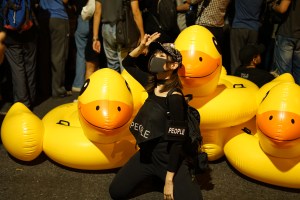With the pandemic wiping out tourism, the turban-wearing mushroom is anxious about his future.
The character, named Psyche-Delhi, is one of Japan’s legions of mascots known for promoting everything from an entire prefecture to a train line with their exuberant antics.
Videos by VICE
But a decline in travel caused by COVID-19 has cast a dark cloud over the future of these delightful, sometimes weird, creatures. This is especially true for new or niche entrants into the competition for attention, such as 7-year-old Psyche-Delhi.

“Psyche-Delhi only went to two events last year,” Misaki Inada, the manager of Psyche-Delhi, told VICE World News. “We’re trying to support local businesses by allowing companies to use his branding for free. Hopefully they will see some profit from that.”
Years of mascot marketing has super-saturated the competition in Japan, creating a hidden hierarchy in this mascot kingdom. The pandemic has only exacerbated the rivalry, revealing the intense competition that could determine the survival of the characters.
Like his colleagues, Psyche-Delhi spends much of his time promoting his bohemian and retro town, Koenji. Before the pandemic, he would show up at large events in his bejeweled pink and white turban mushroom costume, enlivening social gatherings by licking people with his long and red cloth tongue. Known to make a good curry, he also attended Koenji’s annual curry festival.

But the pandemic has forced the city to cancel most in-person events, leaving Psyche-Delhi idling around town without a big audience. And face licking is out of the question.
The town of Koenji made little profit from Psyche-Delhi last year, and it’s unlikely he’ll be swamped with bookings in 2021, although Inada believes his fortune will turn around once the pandemic is over. With most community engagement taking place behind screens, the only real income from the mushroom-like character has been from selling his beef curry.

Psyche-Delhi’s struggle echoes that of hundreds of other mascots that were created to promote tourism. But with streets half-empty and few people to entertain, the nation’s mascots are under pressure to reinvent themselves, and others have pushed new mascots to the market to answer the call of the times.
Taizo Hayashi, the CEO of Alpha Inc, an events company, created Koronon, a pink anti-coronavirus tigercat mascot. It runs around the Shinjuku and Ikebukuro commercial neighborhoods to distribute free face masks and film J-pop dance videos to post on TikTok.

The mascot’s work “doesn’t end until this pandemic is over,” Hayashi said.
Public relations mascots caught on among Japanese businesses over 10 years ago. According to Chris Carlier, an illustrator who also researches mascots, the first to make a splash was Hikonyan, a white cat sporting a samurai helmet.
Hikonyan was designed in 2007 by the Hikone city government in Japan and is the brand ambassador for Hikone Castle, where it shows up three times a day to pose for photos, mingle with visitors and look cute while riding rickshaws.
Soon, Hikonyan gained national attention, turning a considerable profit for Hikone city. Neighboring prefectural governments took note of the cat’s success and created their very own mascots—effectively copycats—in the hopes of injecting life into towns in economic decline, often owing to migration and an aging population. Now, every one of Japan’s 47 prefectures has at least one mascot. At one point, the city of Osaka alone had as many as 92 mascots and had to cull or combine some of them to cut maintenance costs.
Over the years, mascot marketing has become so popular that unofficial symbols, such as Chiitan, a genderless otter that was the subject of John Oliver’s late-night show, command a global following. Kumamon, Kumamoto Prefecture’s black bear mascot, made ¥158 billion ($1.4 billion) in revenue in 2019 alone, mostly through merchandising, and has fans in China, Thailand and the U.S.
Psyche-Delhi has had a much rougher time connecting with his community. Representing a neighborhood in Tokyo known for its racial diversity, the turbaned Psyche-Delhi was the product of a design competition seven years ago held by the Koenji area’s Shopping Street Association.
“People were a little afraid of him at first,” said Inada, Psyche-Delhi’s manager. “They called him gross and, admittedly, children got scared. But as the years went by, people got used to him. Some past visitors have come specifically to meet Psyche-Delhi.”

The pandemic has further dampened his prospects of making it big. “We haven’t received any calls from businesses requesting to use his branding,” Inada said. “Much of what he does at the moment is post on social media.”
Before the pandemic, Inada said, Psyche-Delhi contributed to changing Koenji’s food landscape. “The number of curry restaurants doubled or tripled, which has helped both the district’s economy and its residents. Koenji is known as Tokyo’s curry town,” she explained.
Some mascots have tried their hand at new public service gigs in an effort to keep people’s attention. Goya Sensei, or “Bitter-Melon Teacher,” prays for an end to the pandemic at a local shrine in Fukuchiyama City, Kyoto. Mystery Fish, the fish-man mascot of a local baseball team, choreographed a hand-washing dance. Shinjuku Awawa, a soap bubble mascot, encouraged those in the Shinjuku area to practice good hygiene.
“It’s not just masks Koronon is handing out,” said Hayashi, the creator of the anti-coronavirus tigercat, “it’s also happiness. We want to give courage to people during these trying times.”
Follow Hanako Montgomery on Twitter and Instagram.
Correction: A previous version of this story said Psyche-Delhi hosted Koenji’s annual curry festival. He did not host it, only attended it. We regret the error.
More
From VICE
-

Collage by VICE -

Collage by VICE -

Screenshot: Activision -

(Photo via Shawano County Sheriff’s Office)

